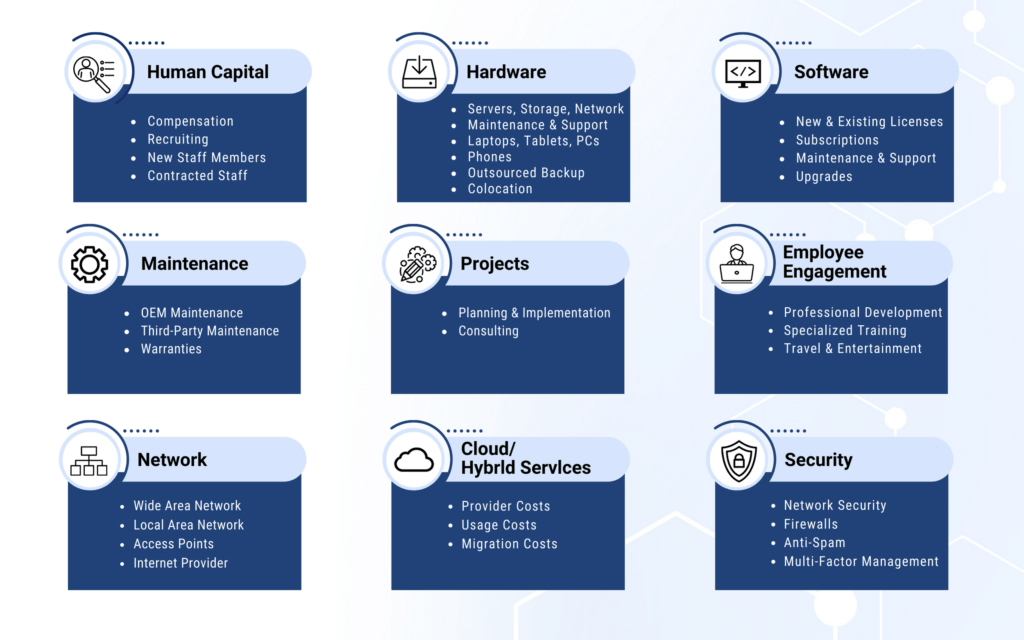For small businesses, managing IT budgets and spending effectively can be a daunting task. With limited resources and the constant need to ensure smooth operations, making wise investment decisions in technology becomes crucial. Having an efficient IT budget is vital to the overall success of your company.
In this blog, we will delve into the basics of IT budgeting and give you practical tips and strategies to help you save money without compromising security or operational efficiency. By implementing these measures, you can optimize the value of your IT budget and pave the way for sustainable growth in the ever-evolving technological landscape.
Table of Contents
What Is IT Budgeting?
IT budgeting refers to allocating financial resources towards an organisation’s information technology systems and services.
An IT budget involves various expenses, including compensation for IT professionals, costs related to developing and upkeep enterprise-wide systems, and expenditures associated with maintaining IT services and infrastructure.
To create a reliable and efficient technology budget, a company must assess its network and systems from various angles, including users, hardware, and current IT vendors. This evaluation phase provides valuable insights for informed budgeting decisions.
Components of IT Budgeting:

Why Is IT Budgeting Important?
Resource Allocation: IT budgeting helps organizations allocate financial resources effectively, ensuring that funds are available to support ongoing IT operations, projects, and initiatives. It enables organisations to prioritise their technology needs and make informed decisions about resource allocation.
Cost Control: IT budgeting enables organisations to control costs related to technology investments. It provides a framework for estimating and managing expenses associated with hardware, software, maintenance, licensing, training, and other IT-related activities. A well-planned budget helps identify areas of overspending or potential cost savings, optimising IT spending.
Planning and forecasting: IT budgeting is essential to strategic planning and forecasting. This process enables organisations to align technology goals with business objectives by setting budgetary targets and timelines. It also helps identify potential funding gaps, allowing for proactive adjustments and risk mitigation.
Risk Management: IT budgeting supports risk management by allocating adequate resources to cybersecurity, data protection, disaster recovery, and compliance. This proactive approach reduces the likelihood and impact of incidents, ensuring business continuity.
Key Steps To Develop An IT Budget:
Review Prior Budgets: Analyze past budgets to understand previous allocations and ensure new budget numbers are strategically justified.
Develop a Strategic Plan: Align the IT budget with the company’s overall strategy to support growth and prioritise key initiatives for the upcoming year.
Identify Priorities: Determine a few critical areas for investment and cost-saving to guide significant spending decisions.
Categorise IT Spending: Organize the budget into capital expenses (hardware, software licenses), operating expenses (subscriptions, maintenance), and project-specific expenses.
Flexibility in Project Budget: Allocate a portion of the budget for project expenses, allowing flexibility to adjust based on other budget factors and unforeseen events.
How To Plan The IT Budget During Digital Transformation?
Businesses must strategically plan their IT budget during digital transformation to align with objectives. Utilising flexible IT budgeting strategies and focusing on continuous improvement enables business owners to explore new markets, enhance performance, and boost revenue.
Success in digital transformation requires active involvement from CIOs and critical stakeholders. They must prioritise value creation, innovation, and aligning technology with strategic business objectives.
Tips For IT Budgeting For Small Business Owners:
Before optimizing your IT budget, you must understand what drives IT spending and how it affects business success. Here are some tips to help you create an adequate IT budget for your small business:
1) Audit Of Current IT Investments And Goal Setting:
To manage your IT budget effectively, conduct a thorough audit of your current IT assets and investments, including hardware, software, infrastructure, and cybersecurity measures. Identify areas of inefficiency or wasteful spending for necessary adjustments and cost reductions.
Once you understand your current IT investments, the next step is to establish clear goals and priorities. This involves aligning your IT investments with your business objectives and determining where to allocate resources for maximum impact.
For example, if your goal is to enhance customer experience and streamline operations, prioritize investments in CRM software, data analytics tools, and user-friendly interfaces for customer-facing applications. These IT investments align with the goal of improving customer satisfaction, optimizing internal processes, and potentially reducing costs.
2) Leverage Cloud Computing Solutions:
Cloud computing refers to delivering computing resources over the internet on a pay-per-use basis. It involves utilizing remote servers hosted on the Internet to store, manage, and process data. Cloud computing solutions provide various services like infrastructure (IaaS), platform (PaaS), and software (SaaS) as a service.
Cloud solutions empower small businesses to store, manage, and process data on remote servers, eliminating the need for expensive hardware and software. This results in significant cost savings, scalability, enhanced security, and improved accessibility. Small businesses can strategically allocate their IT budget and prioritize core business needs with the flexibility provided by cloud computing.
3) Select An Expert: Managed Service Provider (MSP):
A Managed Service Provider (MSP) is a specialized company that offers comprehensive managed services to clients. These services encompass IT infrastructure management, network and security solutions, backup and disaster recovery, technical support, and more. By partnering with an MSP, businesses can offload their IT responsibilities, enabling them to concentrate on core operations.
The right MSP will take the time to understand your business, needs, and goals. They’ll develop a comprehensive IT strategy tailored to your specific requirements. With their industry expertise, they can identify opportunities to save costs, reduce waste, and improve efficiency within your company.
Investing in an MSP empowers your business to streamline operations, enhance security, and leverage technology for growth.
4) Investing Time In Training Of Employees:
For small businesses adopting new technology, providing ample support and training to employees is crucial. This ensures effective and secure use of the software and hardware in their daily tasks.
Without proper support and training, employees may struggle to understand the functionalities and best practices associated with the new technology. This lack of knowledge can lead to inefficient workflows, errors, and potentially costly mistakes. Additionally, employees may use workarounds or inefficient methods to complete tasks, diminishing the benefits and efficiency gains expected from the technology investment.
Steps to facilitate the adoption of new technology in a small business can be:
- Organize walkthrough sessions to introduce the new technology to employees.
- Run a pilot project within a specific team or department to gain feedback and experience.
- Identify super-users who can provide support and training to colleagues.
5 Major IT Budget Mistakes To Avoid:
- Avoid greater long-term costs: Steer clear of decisions that may seem cost-effective initially but result in higher expenses over time.
- Prioritize support and training: Don’t overlook the importance of investing in support and training for employees to maximise the benefits of new technology.
- Account for hardware and software upgrades: Consider the need for regular upgrades and replacements in your IT budget planning to avoid unexpected costs.
- Ensure accurate tracking of technical history: Implement systems to precisely track the history of IT assets, maintenance, and upgrades for better decision-making and cost management.
- Beware of adopting cheap services without comparison: Thoroughly compare and evaluate different service providers to avoid potential issues and ensure quality outcomes
What Is Legacy System Migration And Why Do Businesses Need Them?
Legacy system migration involves transferring data from antiquated software or hardware that may not be compatible with modern technology, such as moving from a traditional file storage system to a cloud-based solution. This process aims to modernise and enhance the existing system while updating the hardware infrastructure to stay up-to-date with technological advancements.
Businesses need legacy System Migration because new technologies perform tasks better than the old systems. Organisations have unique technological needs and are adapting to business changes by implementing innovations.
Initiate Your Journey With Our Trusted IT Experts!
At Ardent, we offer a comprehensive range of budget-friendly services. Experience our IT-managed services, IT Assessment, infrastructure and security services, and more—all conveniently available under one roof. Our tailored solutions align with your specific needs and ensure high-quality results. Enhance your IT capabilities with our expert guidance and support today!
Begin your digital transformation journey today!
When starting a business, research industry benchmarks and consult with IT professionals to understand typical IT expenses. Consider essential hardware and software, basic cybersecurity measures, and initial support and training needs.
Businesses usually allocate their IT budget at the beginning of the fiscal year and review it annually. However, to remain agile and responsive to changing needs, periodic IT budget reviews are essential.
Focus on investments directly supporting your business goals and bringing the most value. Consider improving productivity, enhancing customer experience, and increasing data security. Prioritize projects that offer the highest return on investment and align with your long-term vision.
Yes, ongoing maintenance and support costs should be factored into your IT budget. These expenses include software updates, hardware repairs, cybersecurity measures, and IT support services. Consider outsourcing these services if it aligns with your budget and needs.

